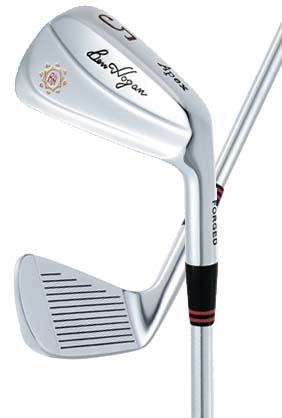|
|
|
 |
Ben Hogan |  |
| About Mr. Hogan Ben Hogan's tournament-winning career stretched 21 years from 1938 to 1959, when at age of 47, he won the Colonial Invitational. Also included in his list of achievements is the award for the Professional Male Athlete of the Year, which he won in 1953, four years after his near-fatal car accident. The early part of his career displayed several indications of the dominance he would later show over the golfing world. For several seasons, he struggled both financially and on the golf course, and in fact, at one stage he contemplated giving up the game altogether. Fortunately, in what he decided would be his make-or-break tournament, the 1937 Oakland Open, during which thieves had stolen the wheels from his car, he shot a final-round 69 to clinch second place, and one of the greatest careers in the game was launched. |
 |
|
| Company Information 1953 Ben Hogan wins three of the four modern majors in one year.Ben Hogan forms the Ben Hogan Company with funding from Marvin Leonard and Pollard Simon. 1954 Mr. Hogan's company releases its first club, the "Precision", after withholding initial sets for quality reasons. 1960 Ben Hogan sells his company to American Machine and Foundry (AMF).Mr. Hogan remains Chairman. 1964 Ben Hogan brings a new concept to driver design with the introduction of the more aerodynamically efficient "Speed Slot". 1968 Mr. Hogan and veteran club designer Gene Sheely team up to build the first constant weight taper-tip steel shaft, the ApexTM. Softer in the long irons, firmer in the short irons, it is believed to be the most consistent shaft in golf. 1972 The Ben Hogan Company introduces the first Apex iron. It is played widely in the professional ranks and gains immediate acceptance on the PGA Tour. 1980 Ben Hogan golf balls are #1 on the PGA Tour, earning more money and winning more money than any other ball. 1984 Minnesota investor Irwin Jacobs buys AMF and sells the rest of its assets, but keeps control of the Ben Hogan Company. 1989 The most successful iron in Ben Hogan history, the Edge, is introduced. For the first time, the feel of forged and the benefits of perimeter-weighting are combined. 1988 AMF (Mr. Jacobs) sells the Ben Hogan Company to Japanese investment firm Cosmo World. 1992 Cosmo World sells the Ben Hogan Company to investor Bill Goodwin. Later, Mr. Goodwin announces the relocation of the Ben Hogan Company to Richmond, VA. The original Ben Hogan factory and warehouse in Fort Worth is closed. 1997 Bill Goodwin sells the Ben Hogan Company to Spalding Sports Worldwide. Justin Leonard wins his first major, the 1997 British Open at Royal Troon, using Ben Hogan Apex irons. 1998 Spalding moves the Ben Hogan clubmaking operation back to Fort Worth and introduces the new Apex iron, designed with input from PGA Tour players Justin Leonard and Hal Sutton. 1999 The new Ben Hogan Apex Plus! irons are introduced. Like the original Edge, the Apex Plus provides perimeter-weighted forgiveness and forged feel. |
Apex Irons It was Mr. Hogan's gift. His ability to grasp the mechanics of the game and translate them into simple, handsome and efficient clubs. During the past 47 years, this gift has been the inspiration for the Ben Hogan Company's most memorable Apex models. The Ben Hogan Apex Iron continues that legacy. Based on input from Pro Tour players like Justin Leonard and Hal Sutton, the 1998 Apex Iron combines some of the best features of the '88 and '94 Apex models. The result is the feel and performance you would expect from a forged blade, incorporated into the most playable blade design available today. Features and Benefits -Forged 1030 Carbon Steel for excellent feel and feedback -Moderate toe relief and muscleback design for solid feel and easy control -Progressive offset for optimum trajectory control throughout the set -Top-line relief, rolled leading edge and traditional shaping for improved alignment -Fort Worth craftsmanship and uncompromised commitment to quality |
|
The Ben Hogan Fort Worth Manufacturing Process |
To Ben Hogan Website |
|